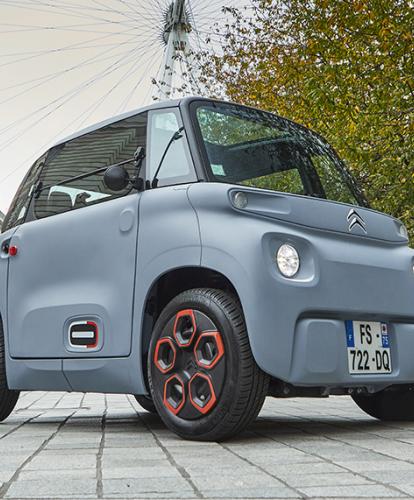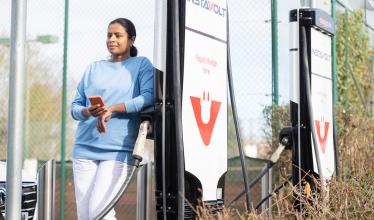Zapmap verdict: “The Citroen Ami offers drivers a cheap but characterful driving experience for short trips in built up areas.”

- ● OTR: TBC
- ● Category: Quadricycle
- ● Tax: £0 VED – 0% BIK
- ● Cost to charge: 90p
- ● Emissions: 0 g/km CO2
- ● Cost per mile of range: TBC
Range & charging

Citroen’s electric offensive has kicked off on two fronts. The e-C4 is a family-sized EV, focusing on comfort and practicality, whilst the other, the Ami . . . doesn’t. Technically a quadricycle rather than a car, it differs from its main rival, Renault’s Twizy, in the fact that it has a conventional side-by-side seating configuration for two people, and actual doors. Covering what might seem a paltry 43 miles on a charge, the Ami is targeted at urban mobility users, and looks to fit its brief well.
There is one configuration available:
Those looking at the Ami as a replacement for their car may well be disappointed. The little Citroen is not intended to be compared to ‘normal’ cars; instead, as a quadricycle, the Ami is more of a challenger to mopeds, public transport, and bicycles. In certain countries on the continent, drivers younger than 17 can get behind the wheel with a moped licence, though that won’t be the case in the UK – if it comes to Britain. There’s no confirmation yet as to whether Citroen will offer the Ami for sale on these shores, but it is optimistic that it can persuade the powers that be if enough support is registered. And the Ami will drum up plenty of support.
Charging is carried out via the three-pin plug that can be found within a section of the passenger (on left-hand drive models) door-frame. It will take around three hours to charge the 5.5 kWh battery, meaning long-distance EV-ing is clearly out of the question. The Ami is aimed at short trips however, and considering the average UK driven journey is around half the Ami’s real-world range, there should be few issues from buyers in terms of driving range.
On the road

Testing the Ami on a chilly day around Coventry, the Citroen’s benefit over the Twizy was immediately apparent. Featuring doors – rather than barriers with optional tent windows – the Ami was instantly more refined and comfortable than Renault’s take on the quadricycle (and I am a fan of the Twizy). Unable to really challenge the driving range, calculations worked out at around 35 miles being possible on a charge. This is whilst primarily driving around Coventry’s city centre, as the Ami can’t go on motorways, and it’s recommended to avoid faster roads.
This is partly because drivers sit in what is a very compact car, and the Ami feels small even next to conventional superminis. The other factor is that the top speed is just 28 mph, and driving the Ami, you really wouldn’t want to jostle around faster vehicles. Suspension is stiff, and the turning circle tiny, all of which make the Ami poorly suited to high speeds if it could ever reach them. Instead, the Citroen’s 6 kW electric motor gets the Ami up to speed at a relatively brisk pace – though don’t expect ‘normal’ EV pick-up as the Ami has less than 10% of the power of a Nissan Leaf for example.
In terms of handling, the Ami comes across as a poor substitute for a car, but then again it’s not meant to be. Equally, it’s a hoot to drive, putting a smile on your face as big as the ones on those of passers-by. Just about everywhere I went in the Ami I saw pedestrians and those in other cars/vans point, wave, and smile. It’s perfectly suited to narrow streets, tight car parks, and tight junctions.
Comfort & Practicality

Considering how small the Ami’s footprint is, there’s a surprising amount of space inside. Thinking about things, this shouldn’t be much of a surprise considering the Ami’s shape. The one-box design means interior space is maximised, and there is plenty of head and leg room for a pair of tall adults. There’s a bit of space behind the seats to shove some bags, but essentially the rear of the seats sits flush with the back of the car. The main ‘boot’ space for most will be the passenger seat and footwell when there’s no one else there, though there’s a spot for a large-ish suitcase forward of the passenger’s feet and under the dash for added practicality.
Controls are simple and minimalist, with even the drive selector located between the driver’s seat and the door. The lights are always on when the Ami is, and there is a small digital instrument cluster for essentials. Otherwise, there’s a phone cradle which most will use for their media/navigation needs, and there are plenty of cubby holes dotted along the dashboard. Plastics used in the cabin are basic, but easy to maintain and clean – a key feature of the Ami – but there are flashes of colour for items like the cubby hole liners, fabric door handles, and trim for mats and storage nets. It lifts what would otherwise be a drab interior, and with Citroen’s personalisation offerings, the Ami certainly shouldn’t be a drab car to look at.
Tech & Specifications

There’s not a lot of kit in the Ami in interests of costs and lightness. These two features are core facets of the Ami’s make up. By being lightweight – tipping the scales at less than half a tonne including battery, when a Tesla battery weighs more than the Ami in total – it improves efficiency. Costs are saved further by only having around half the number of different body panels than most vehicles, even small cars. The front bumper/light surround/bonnet is the same shape as that at the rear, with simply different coloured lights fitted to differentiate the front and back. There’s also a panel extending the rear glass section, but essentially the front and rear of the Ami are identical. This effort in saving manufacturing and maintenance costs has even been extended to the doors. Both are exactly the same, with the driver’s door hinged at the rear and the passenger’s at the front. Fewer different parts means it’s a cheaper vehicle to build and repair.
Whilst the Citroen isn’t for everyone, there are a great many households that would use an Ami for a significant part of their daily mileage. Those who have a short commute, or pop to the shops by themselves will easily be able to run an Ami, either as their only vehicle – mainly in city centres – or as a second vehicle. And that’s before considering the costs. Although not available yet in the UK, the Ami costs around 6,000 euros in France – £5,400 at today’s exchange rates – though it is also offered on a car subscription service at around 20 euros a month or as a pay-as-you-go car sharing/hiring service. As such, it’s extraordinarily good value for something that sits somewhere between a moped and a car; and there are plenty of drivers out there that would welcome the Ami.
All information above correct at time of publication. Official economy figures, pricing, and tax rates supplied by the manufacturer. Cost to charge based on 0-100% charge at home on a tariff of 16 p/kWh.
- ● Citroen Ami – 6 kW – 5.5 kWh – 43 miles



